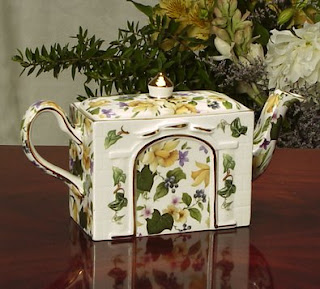
History of China
China is a commonly used term that broadly describes any ceramic tableware. The term developed from "Porcelain from China", a phrase used since the 15th century when chinese porcelain began arriving in the west.
Porcelain was first produced in China, where the essential ingredient, kaolin was widely available. It was not until the beginning of the 18th century that kaolin became available in Europe, and manufacturers could move from making soft-paste porcelain to the more durable and economically viable hard-paste porcelain.
The Story of Tea
Tea and fine china are closely linked. How often have you heard someone say "... tea tastes better from a china cup ..." or "... afternoon tea would not be afternoon tea if it wasn't served in china ...".
"The mere chink of cups and saucers turns the mind to happy repose."George Gissie
The Origins of Tea
Legend has it that, over 5,000 years ago the Chinese emperor Shen Nong pronounced that all drinking water should be boiled. One day, as the emperor was journeying to a distant town, he stopped to rest and his servants began to boil water. Dried leaves from a nearby bush fell into the hot water. The emperor drank the infusion, and found it to be most refreshing. Thus, tea was born.
Tea consumption spread throughout China and tea drinking became an integral part of the culture. The first book on tea was written in 800 A.D.
"Its liquor is like the sweetest dew from Heaven"From the 8th-century 'The Classic of Tea'by Lu Yu (trans. F. Carpenter)
Buddhist monks took their knowledge of tea from China to Japan, and so the story of tea began to spread around the world.
Tea became popular in Europe and America in the 17th century. With royal endorsement (King Charles II was a keen tea drinker!) tea quickly proved popular enough in England to replace ale as the national drink. Consumption rose from 40,000 pounds in 1699 to 240,000 pounds by 1708 and the beverage was enjoyed by all levels of society.
Afternoon Tea Traditions
Traditionally the English had eaten two main meals-breakfast and dinner. Breakfast was a substantial meal of perhaps ale, bread and beef, followed by a very long day until dinner which tended to be a massive meal at the end of the day.
Anna, the Duchess of Bedford (1788-1861) is attributed the development of Afternoon Tea. Feeling hungry during the long wait for dinner, she invited friends to join her for an additional meal around 5pm. She served small cakes, bread and butter sandwiches, and, of course, tea. The practice was quickly followed by other social hostesses, and a ritual of making and serving tea to stimulate conversation soon developed. The hostess' finest table linens, silverware and of course china were all used as part of the ritual to impress visitors.
China is a commonly used term that broadly describes any ceramic tableware. The term developed from "Porcelain from China", a phrase used since the 15th century when chinese porcelain began arriving in the west.
Porcelain was first produced in China, where the essential ingredient, kaolin was widely available. It was not until the beginning of the 18th century that kaolin became available in Europe, and manufacturers could move from making soft-paste porcelain to the more durable and economically viable hard-paste porcelain.
The Story of Tea
Tea and fine china are closely linked. How often have you heard someone say "... tea tastes better from a china cup ..." or "... afternoon tea would not be afternoon tea if it wasn't served in china ...".
"The mere chink of cups and saucers turns the mind to happy repose."George Gissie
The Origins of Tea
Legend has it that, over 5,000 years ago the Chinese emperor Shen Nong pronounced that all drinking water should be boiled. One day, as the emperor was journeying to a distant town, he stopped to rest and his servants began to boil water. Dried leaves from a nearby bush fell into the hot water. The emperor drank the infusion, and found it to be most refreshing. Thus, tea was born.
Tea consumption spread throughout China and tea drinking became an integral part of the culture. The first book on tea was written in 800 A.D.
"Its liquor is like the sweetest dew from Heaven"From the 8th-century 'The Classic of Tea'by Lu Yu (trans. F. Carpenter)
Buddhist monks took their knowledge of tea from China to Japan, and so the story of tea began to spread around the world.
Tea became popular in Europe and America in the 17th century. With royal endorsement (King Charles II was a keen tea drinker!) tea quickly proved popular enough in England to replace ale as the national drink. Consumption rose from 40,000 pounds in 1699 to 240,000 pounds by 1708 and the beverage was enjoyed by all levels of society.
Afternoon Tea Traditions
Traditionally the English had eaten two main meals-breakfast and dinner. Breakfast was a substantial meal of perhaps ale, bread and beef, followed by a very long day until dinner which tended to be a massive meal at the end of the day.
Anna, the Duchess of Bedford (1788-1861) is attributed the development of Afternoon Tea. Feeling hungry during the long wait for dinner, she invited friends to join her for an additional meal around 5pm. She served small cakes, bread and butter sandwiches, and, of course, tea. The practice was quickly followed by other social hostesses, and a ritual of making and serving tea to stimulate conversation soon developed. The hostess' finest table linens, silverware and of course china were all used as part of the ritual to impress visitors.
















